Cover
Title
Copyright
Preface to the Second Edition
About the Author
Contents
1 Introduction to Analog Design
1.1 Why Analog?
1.1.1 Sensing and Processing Signals
1.1.2 When Digital Signals Become Analog
1.1.3 Analog Design Is in Great Demand
1.1.4 Analog Design Challenges
1.2 Why Integrated?
1.3 Why CMOS?
1.4 Why This Book?
1.5 Levels of Abstraction
2 Basic MOS Device Physics
2.1 General Considerations
2.1.1 MOSFET as a Switch
2.1.2 MOSFET Structure
2.1.3 MOS Symbols
2.2 MOS I/V Characteristics
2.2.1 Threshold Voltage
2.2.2 Derivation of I/V Characteristics
2.2.3 MOS Transconductance
2.3 Second-Order Effects
2.4 MOS Device Models
2.4.1 MOS Device Layout
2.4.2 MOS Device Capacitances
2.4.3 MOS Small-Signal Model
2.4.4 MOS SPICE models
2.4.5 NMOS Versus PMOS Devices
2.4.6 Long-Channel Versus Short-Channel Devices
2.5 Appendix A: FinFETs
2.6 Appendix B: Behavior of a MOS Device as a Capacitor
3 Single-Stage Amplifiers
3.1 Applications
3.2 General Considerations
3.3 Common-Source Stage
3.3.1 Common-Source Stage with Resistive Load
3.3.2 CS Stage with Diode-Connected Load
3.3.3 CS Stage with Current-Source Load
3.3.4 CS Stage with Active Load
3.3.5 CS Stage with Triode Load
3.3.6 CS Stage with Source Degeneration
3.4 Source Follower
3.5 Common-Gate Stage
3.6 Cascode Stage
3.6.1 Folded Cascode
3.7 Choice of Device Models
4 Differential Amplifiers
4.1 Single-Ended and Differential Operation
4.2 Basic Differential Pair
4.2.1 Qualitative Analysis
4.2.2 Quantitative Analysis
4.2.3 Degenerated Differential Pair
4.3 Common-Mode Response
4.4 Differential Pair with MOS Loads
4.5 Gilbert Cell
5 Current Mirrors and Biasing Techniques
5.1 Basic Current Mirrors
5.2 Cascode Current Mirrors
5.3 Active Current Mirrors
5.3.1 Large-Signal Analysis
5.3.2 Small-Signal Analysis
5.3.3 Common-Mode Properties
5.3.4 Other Properties of Five-Transistor OTA
5.4 Biasing Techniques
5.4.1 CS Biasing
5.4.2 CG Biasing
5.4.3 Source Follower Biasing
5.4.4 Differential Pair Biasing
6 Frequency Response of Amplifiers
6.1 General Considerations
6.1.1 Miller Effect
6.1.2 Association of Poles with Nodes
6.2 Common-Source Stage
6.3 Source Followers
6.4 Common-Gate Stage
6.5 Cascode Stage
6.6 Differential Pair
6.6.1 Differential Pair with Passive Loads
6.6.2 Differential Pair with Active Load
6.7 Gain-Bandwidth Trade-Offs
6.7.1 One-Pole Circuits
6.7.2 Multi-Pole Circuits
6.8 Appendix A: Extra Element Theorem
6.9 Appendix B: Zero-Value Time Constant Method
6.10 Appendix C: Dual of Miller's Theorem
7 Noise
7.1 Statistical Characteristics of Noise
7.1.1 Noise Spectrum
7.1.2 Amplitude Distribution
7.1.3 Correlated and Uncorrelated Sources
7.1.4 Signal-to-Noise Ratio
7.1.5 Noise Analysis Procedure
7.2 Types of Noise
7.2.1 Thermal Noise
7.2.2 Flicker Noise
7.3 Representation of Noise in Circuits
7.4 Noise in Single-Stage Amplifiers
7.4.1 Common-Source Stage
7.4.2 Common-Gate Stage
7.4.3 Source Followers
7.4.4 Cascode Stage
7.5 Noise in Current Mirrors
7.6 Noise in Differential Pairs
7.7 Noise-Power Trade-Off
7.8 Noise Bandwidth
7.9 Problem of Input Noise Integration
7.10 Appendix A: Problem of Noise Correlation
8 Feedback
8.1 General Considerations
8.1.1 Properties of Feedback Circuits
8.1.2 Types of Amplifiers
8.1.3 Sense and Return Mechanisms
8.2 Feedback Topologies
8.2.1 Voltage-Voltage Feedback
8.2.2 Current-Voltage Feedback
8.2.3 Voltage-Current Feedback
8.2.4 Current-Current Feedback
8.3 Effect of Feedback on Noise
8.4 Feedback Analysis Difficulties
8.5 Effect of Loading
8.5.1 Two-Port Network Models
8.5.2 Loading in Voltage-Voltage Feedback
8.5.3 Loading in Current-Voltage Feedback
8.5.4 Loading in Voltage-Current Feedback
8.5.5 Loading in Current-Current Feedback
8.5.6 Summary of Loading Effects
8.6 Bode's Analysis of Feedback Circuits
8.6.1 Observations
8.6.2 Interpretation of Coefficients
8.6.3 Bode's Analysis
8.6.4 Blackman's Impedance Theorem
8.7 Middlebrook's Method
8.8 Loop Gain Calculation Issues
8.8.1 Preliminary Concepts
8.8.2 Difficulties with Return Ratio
8.9 Alternative Interpretations of Bode's Method
9 Operational Amplifiers
9.1 General Considerations
9.1.1 Performance Parameters
9.2 One-Stage Op Amps
9.2.1 Basic Topologies
9.2.2 Design Procedure
9.2.3 Linear Scaling
9.2.4 Folded-Cascode Op Amps
9.2.5 Folded-Cascode Properties
9.2.6 Design Procedure
9.3 Two-Stage Op Amps
9.3.1 Design Procedure
9.4 Gain Boosting
9.4.1 Basic Idea
9.4.2 Circuit Implementation
9.4.3 Frequency Response
9.5 Comparison
9.6 Output Swing Calculations
9.7 Common-Mode Feedback
9.7.1 Basic Concepts
9.7.2 CM Sensing Techniques
9.7.3 CM Feedback Techniques
9.7.4 CMFB in Two-Stage Op Amps
9.8 Input Range Limitations
9.9 Slew Rate
9.10 High-Slew-Rate Op Amps
9.10.1 One-Stage Op Amps
9.10.2 Two-Stage Op Amps
9.11 Power Supply Rejection
9.12 Noise in Op Amps
10 Stability and Frequency Compensation
10.1 General Considerations
10.2 Multipole Systems
10.3 Phase Margin
10.4 Basic Frequency Compensation
10.5 Compensation of Two-Stage Op Amps
10.6 Slewing in Two-Stage Op Amps
10.7 Other Compensation Techniques
10.8 Nyquist's Stability Criterion
10.8.1 Motivation
10.8.2 Basic Concepts
10.8.3 Construction of Polar Plots
10.8.4 Cauchy's Principle
10.8.5 Nyquist's Method
10.8.6 Systems with Poles at Origin
10.8.7 Systems with Multiple 180° Crossings
11 Nanometer Design Studies
11.1 Transistor Design Considerations
11.2 Deep-Submicron Effects
11.3 Transconductance Scaling
11.4 Transistor Design
11.4.1 Design for Given I[sub(D)] and V[sub(DS, min)]
11.4.2 Design for Given g[sub(m)] and I[sub(D)]
11.4.3 Design for Given g[sub(m)] and V[sub(DS, min)]
11.4.4 Design for a Given g[sub(m)]
11.4.5 Choice of Channel Length
11.5 Op Amp Design Examples
11.5.1 Telescopic Op Amp
11.5.2 Two-Stage Op Amp
11.6 High-Speed Amplifier
11.6.1 General Considerations
11.6.2 Op Amp Design
11.6.3 Closed-Loop Small-Signal Performance
11.6.4 Op Amp Scaling
11.6.5 Large-Signal Behavior
11.7 Summary
12 Bandgap References
12.1 General Considerations
12.2 Supply-Independent Biasing
12.3 Temperature-Independent References
12.3.1 Negative-TC Voltage
12.3.2 Positive-TC Voltage
12.3.3 Bandgap Reference
12.4 PTAT Current Generation
12.5 Constant-G[sub(m)] Biasing
12.6 Speed and Noise Issues
12.7 Low-Voltage Bandgap References
12.8 Case Study
13 Introduction to Switched-Capacitor Circuits
13.1 General Considerations
13.2 Sampling Switches
13.2.1 MOSFETS as Switches
13.2.2 Speed Considerations
13.2.3 Precision Considerations
13.2.4 Charge Injection Cancellation
13.3 Switched-Capacitor Amplifiers
13.3.1 Unity-Gain Sampler/Buffer
13.3.2 Noninverting Amplifier
13.3.3 Precision Multiply-by-Two Circuit
13.4 Switched-Capacitor Integrator
13.5 Switched-Capacitor Common-Mode Feedback
14 Nonlinearity and Mismatch
14.1 Nonlinearity
14.1.1 General Considerations
14.1.2 Nonlinearity of Differential Circuits
14.1.3 Effect of Negative Feedback on Nonlinearity
14.1.4 Capacitor Nonlinearity
14.1.5 Nonlinearity in Sampling Circuits
14.1.6 Linearization Techniques
14.2 Mismatch
14.2.1 Effect of Mismatch
14.2.2 Offset Cancellation Techniques
14.2.3 Reduction of Noise by Offset Cancellation
14.2.4 Alternative Definition of CMRR
15 Oscillators
15.1 General Considerations
15.2 Ring Oscillators
15.3 LC Oscillators
15.3.1 Basic Concepts
15.3.2 Cross-Coupled Oscillator
15.3.3 Colpitts Oscillator
15.3.4 One-Port Oscillators
15.4 Voltage-Controlled Oscillators
15.4.1 Tuning in Ring Oscillators
15.4.2 Tuning in LC Oscillators
15.5 Mathematical Model of VCOs
16 Phase-Locked Loops
16.1 Simple PLL
16.1.1 Phase Detector
16.1.2 Basic PLL Topology
16.1.3 Dynamics of Simple PLL
16.2 Charge-Pump PLLs
16.2.1 Problem of Lock Acquisition
16.2.2 Phase/Frequency Detector
16.2.3 Charge Pump
16.2.4 Basic Charge-Pump PLL
16.3 Nonideal Effects in PLLs
16.3.1 PFD/CP Nonidealities
16.3.2 Jitter in PLLs
16.4 Delay-Locked Loops
16.5 Applications
16.5.1 Frequency Multiplication and Synthesis
16.5.2 Skew Reduction
16.5.3 Jitter Reduction
17 Short-Channel Effects and Device Models
17.1 Scaling Theory
17.2 Short-Channel Effects
17.2.1 Threshold Voltage Variation
17.2.2 Mobility Degradation with Vertical Field
17.2.3 Velocity Saturation
17.2.4 Hot Carrier Effects
17.2.5 Output Impedance Variation with Drain-Source Voltage
17.3 MOS Device Models
17.3.1 Level 1 Model
17.3.2 Level 2 Model
17.3.3 Level 3 Model
17.3.4 BSIM Series
17.3.5 Other Models
17.3.6 Charge and Capacitance Modeling
17.3.7 Temperature Dependence
17.4 Process Corners
18 CMOS Processing Technology
18.1 General Considerations
18.2 Wafer Processing
18.3 Photolithography
18.4 Oxidation
18.5 Ion Implantation
18.6 Deposition and Etching
18.7 Device Fabrication
18.7.1 Active Devices
18.7.2 Passive Devices
18.7.3 Interconnects
18.8 Latch-Up
19 Layout and Packaging
19.1 General Layout Considerations
19.1.1 Design Rules
19.1.2 Antenna Effect
19.2 Analog Layout Techniques
19.2.1 Multifinger Transistors
19.2.2 Symmetry
19.2.3 Shallow Trench Isolation Issues
19.2.4 Well Proximity Effects
19.2.5 Reference Distribution
19.2.6 Passive Devices
19.2.7 Interconnects
19.2.8 Pads and ESD Protection
19.3 Substrate Coupling
19.4 Packaging
Index
A
B
C
D
E
F
G
H
I
J
K
L
M
N
O
P
Q
R
S
T
U
V
W
T
Z
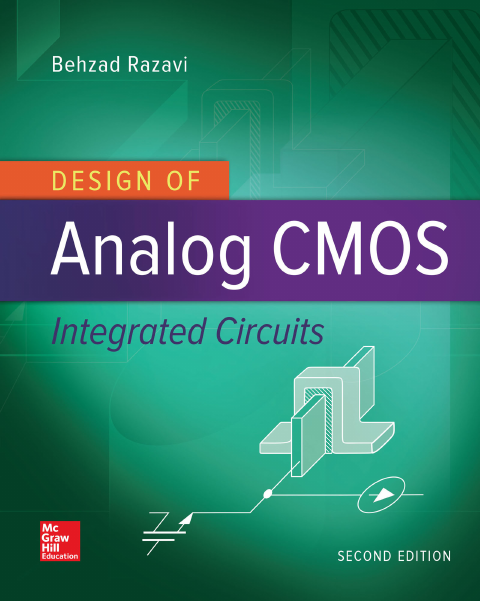
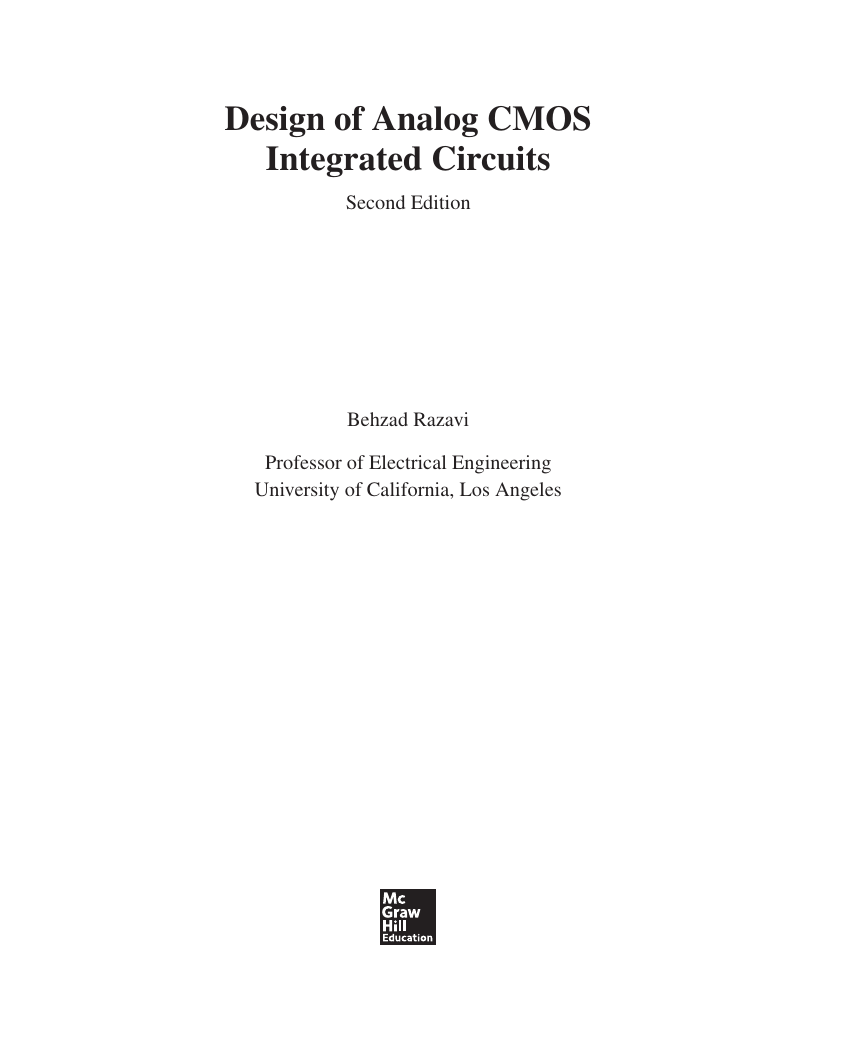
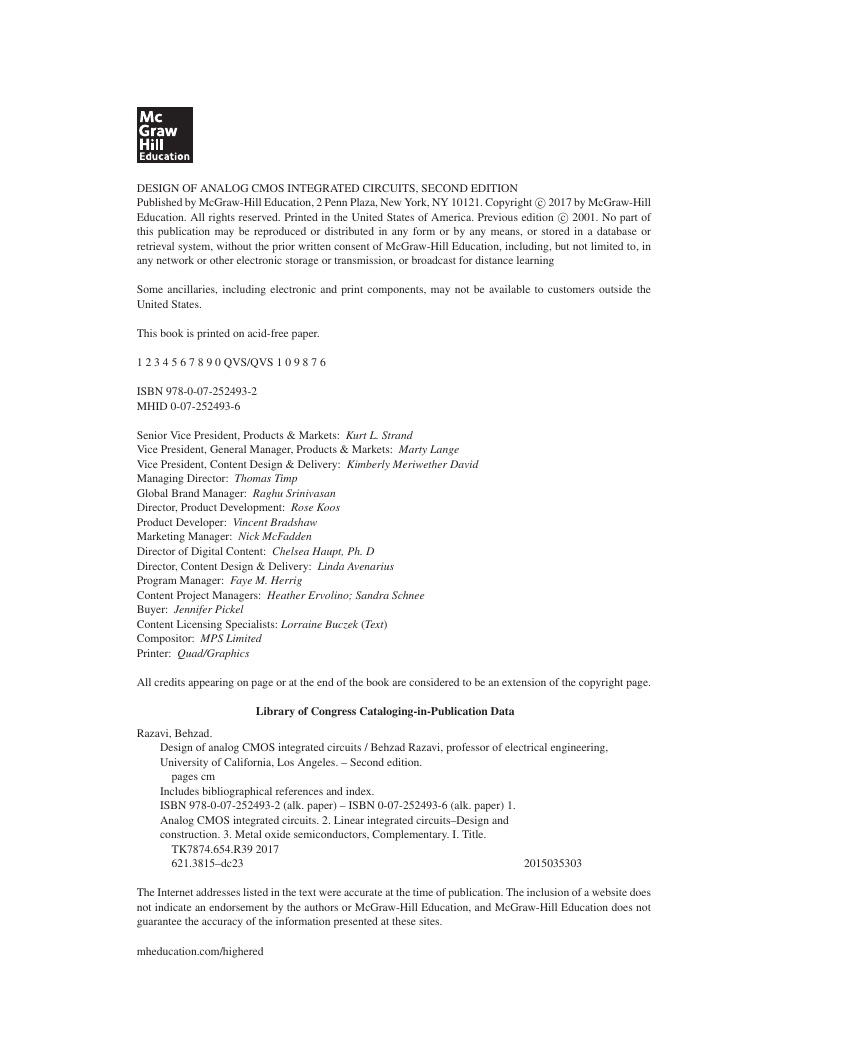

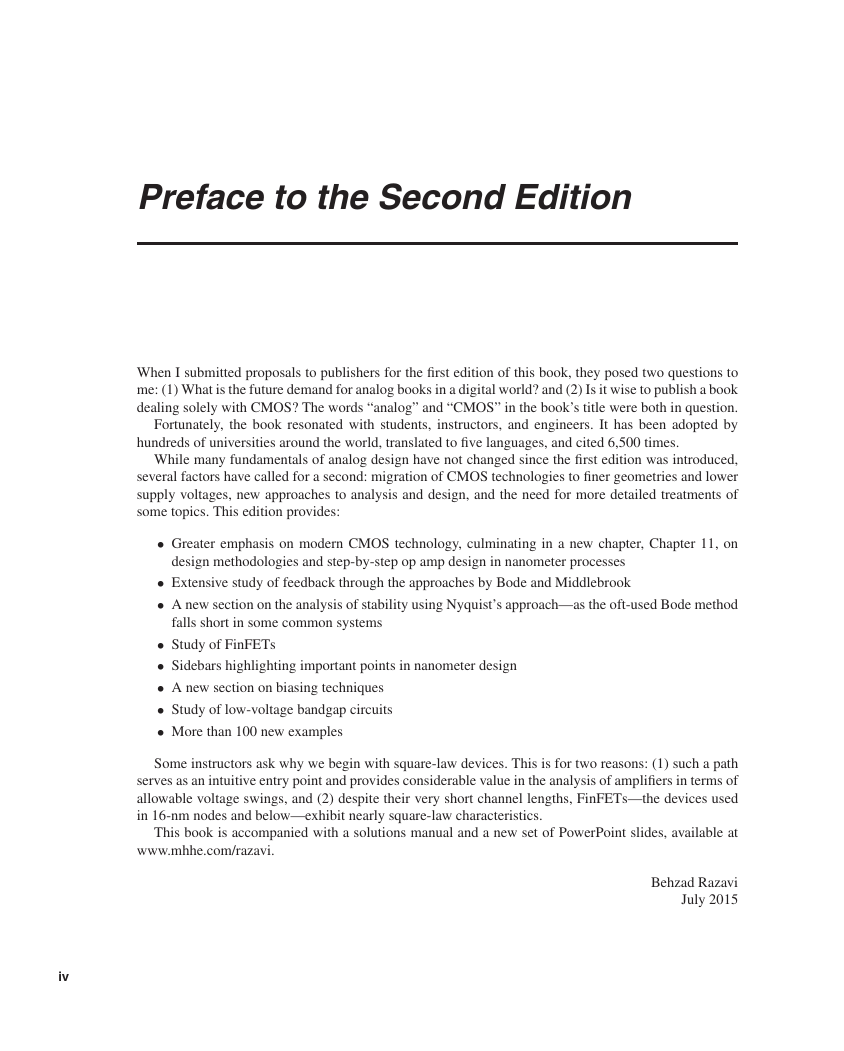
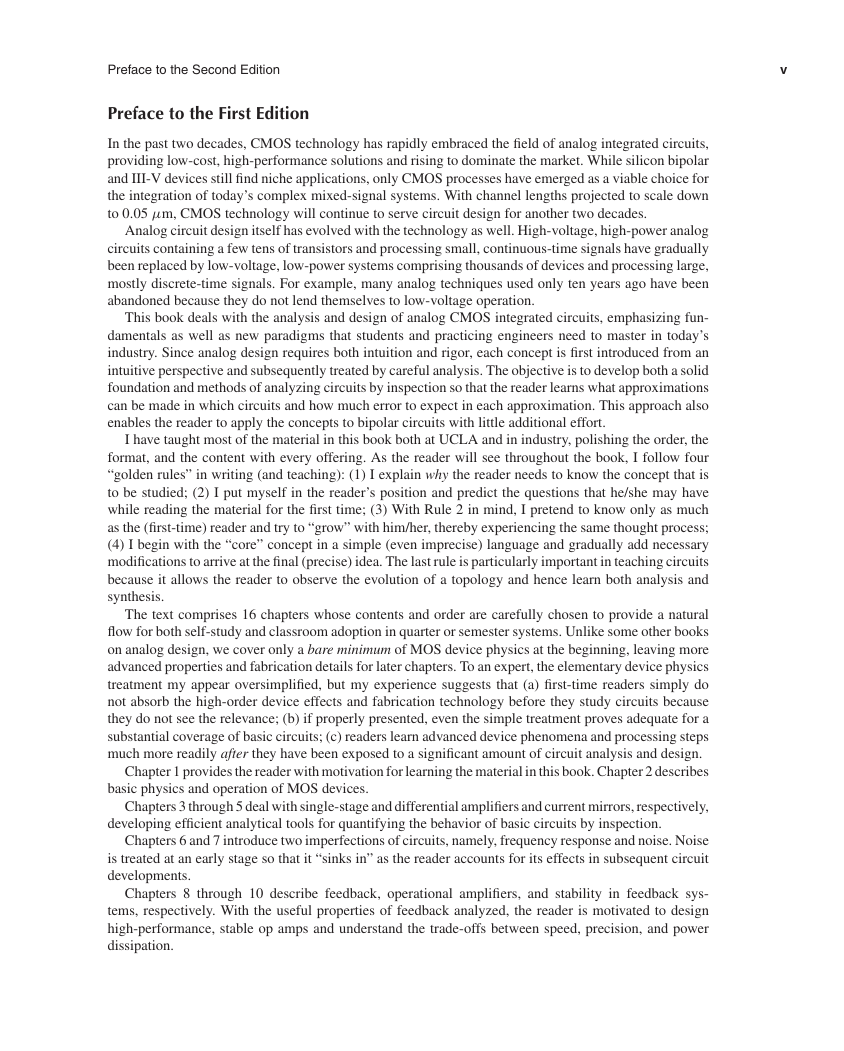
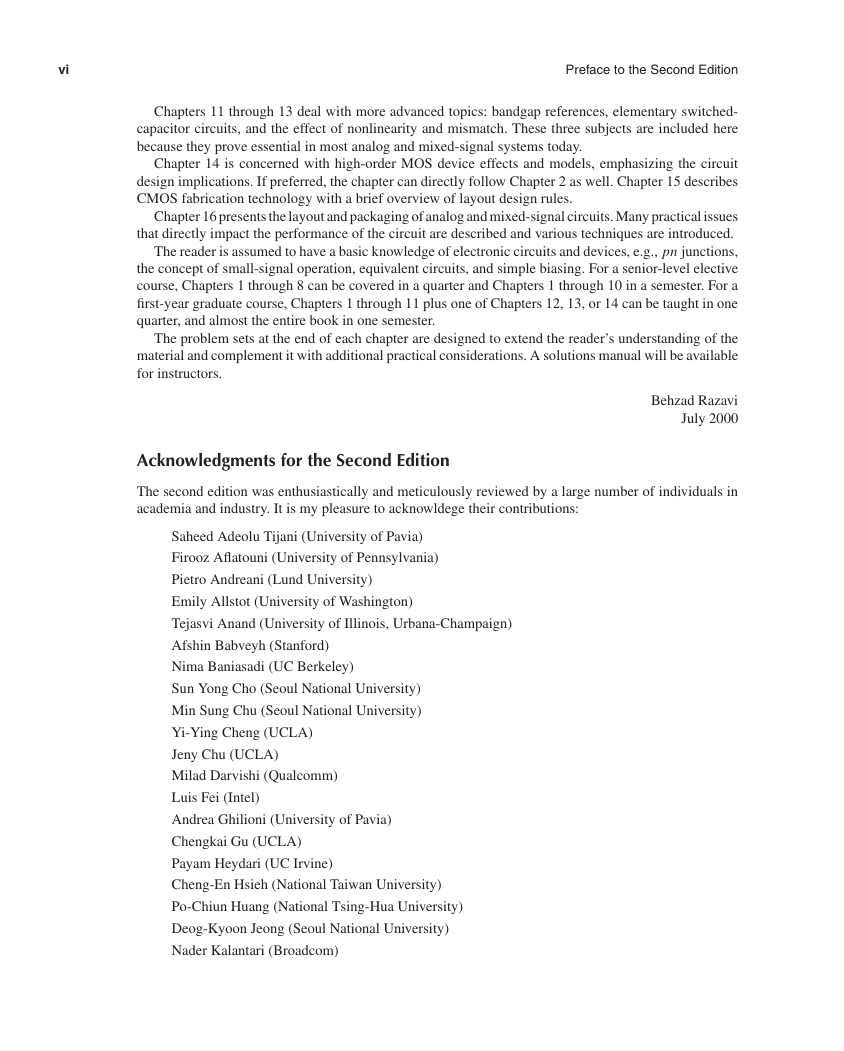
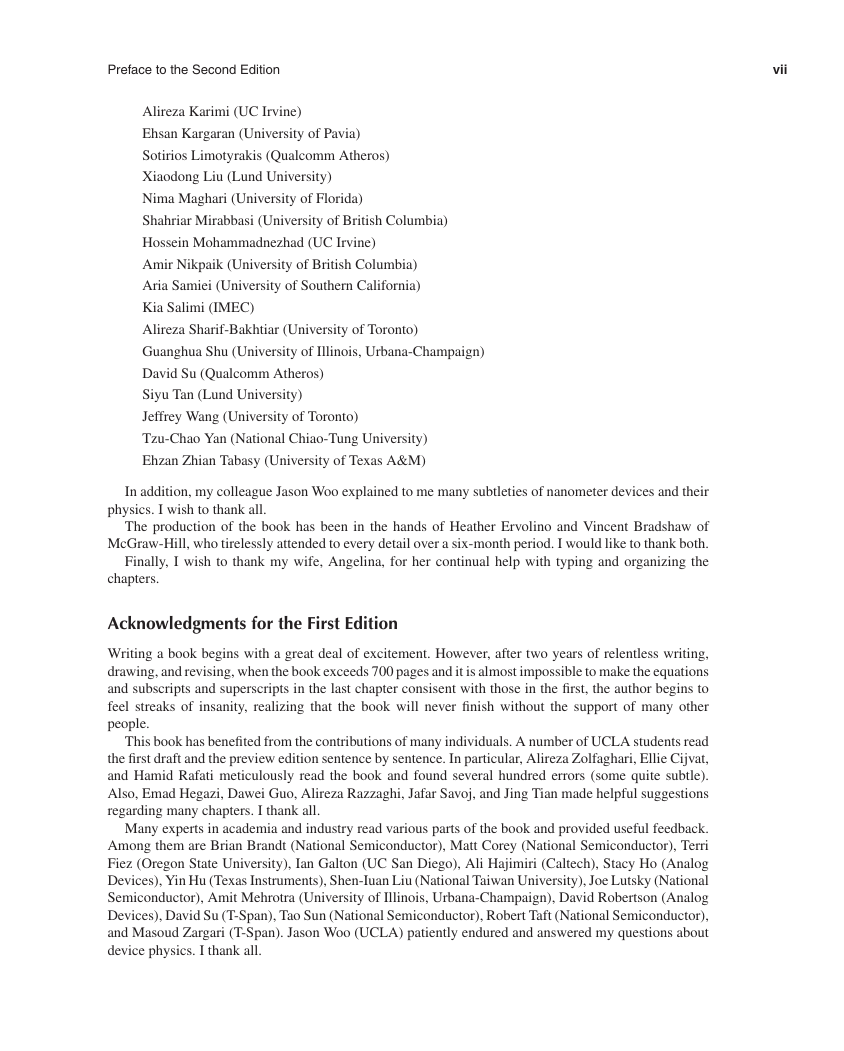








 2023年江西萍乡中考道德与法治真题及答案.doc
2023年江西萍乡中考道德与法治真题及答案.doc 2012年重庆南川中考生物真题及答案.doc
2012年重庆南川中考生物真题及答案.doc 2013年江西师范大学地理学综合及文艺理论基础考研真题.doc
2013年江西师范大学地理学综合及文艺理论基础考研真题.doc 2020年四川甘孜小升初语文真题及答案I卷.doc
2020年四川甘孜小升初语文真题及答案I卷.doc 2020年注册岩土工程师专业基础考试真题及答案.doc
2020年注册岩土工程师专业基础考试真题及答案.doc 2023-2024学年福建省厦门市九年级上学期数学月考试题及答案.doc
2023-2024学年福建省厦门市九年级上学期数学月考试题及答案.doc 2021-2022学年辽宁省沈阳市大东区九年级上学期语文期末试题及答案.doc
2021-2022学年辽宁省沈阳市大东区九年级上学期语文期末试题及答案.doc 2022-2023学年北京东城区初三第一学期物理期末试卷及答案.doc
2022-2023学年北京东城区初三第一学期物理期末试卷及答案.doc 2018上半年江西教师资格初中地理学科知识与教学能力真题及答案.doc
2018上半年江西教师资格初中地理学科知识与教学能力真题及答案.doc 2012年河北国家公务员申论考试真题及答案-省级.doc
2012年河北国家公务员申论考试真题及答案-省级.doc 2020-2021学年江苏省扬州市江都区邵樊片九年级上学期数学第一次质量检测试题及答案.doc
2020-2021学年江苏省扬州市江都区邵樊片九年级上学期数学第一次质量检测试题及答案.doc 2022下半年黑龙江教师资格证中学综合素质真题及答案.doc
2022下半年黑龙江教师资格证中学综合素质真题及答案.doc